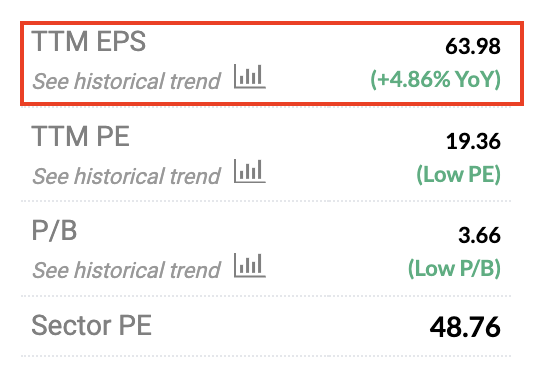Stock splits and bonus issues impact a company’s EPS. Do past EPS figures change too? Learn why financial portals (like moneycontrol) adjust historical data and what it means to us.
A reader (Raj Sharma) recently asked, “After a stock split, will the past EPS figures also gets adjusted on moneycontrol? What happens in the case of a bonus issue?”
This is a fundamental question for anyone who is starting out to read companies financial reports on portals like moneycontrol. Understanding how corporate actions like stock splits and bonus issues affect EPS is key to interpreting financial data correctly.
Without this knowledge, we might misread a company’s performance.
In this post, we’ll dive into the impact of stock splits and bonus issues on EPS and why financial portals adjust historical data.
Let’s learn more about it.
Example
Recently, DR Reddys Labs announced a stock split (5:1) The Ex-split date for this share was 28-Oct-2024.
Before the split, the reported EPS number of the company was like this:
| Quarterly Result (Rs.) | Sep ’24 | Jun ’24 | Mar ’24 | Dec ’23 |
|---|---|---|---|---|
| Basic EPS | 80.45 | 83.61 | 78.66 | 82.94 |
| EPS (TTM) | 325.66 | – | – | – |
Note, just a month back (on Sep’24), the company reported the EPS (TTM) of Rs.325.66 per share.
But when you’ll check the portal after the ex-split date, the EPS (TTM) number for the company on its home page will change. It looks, like this now [ EPS(TTM) = 63.98 – about one fifth of what’s being reported in the quarterly statements page).

If someone know, the concept of stock split and bonus issue, the difference between between the “home page data” and “quarterly report page” is understandable.
But I think, the question that I received from the reader (Raj Sharma) who not about the reason for the difference in values between the two pages. I think, he wants to ask, what happens to the past year EPS numbers of the company?
Do portals like moneycontrol will report the ex-split number only after the ex-split date or they will change the per share data (like EPS, P/E, etc) for all the previous years and quarters?
The portal must change the per share data for all the previous reported years.
The question is, when this change will be visible in the financial reports page (quarter data, P&L account, ratios page, etc)? Frankly, I do not know. I’ve experienced a mismatch between home page data (like EPS, P/E) and financial report data for many quarters.
I hope moneycontrol finds a way to resolve this issue. Otherwise, I know many deep readers like Raj Sharma will continue to get confused.
Now, because I’m writing on this topic of “Stock Split” and “Bonus Issue”, for my readers who are not very conversant with the implication of these corporate actions on the financial ratios, I will give a few basics.
What is EPS and Why Does It Matter?
EPS, or Earnings Per Share, is a key financial metric that tells you how much profit a company earns per outstanding share. It’s calculated as:
EPS = Net Profit / Total Number of Shares Outstanding
A rising EPS indicates a company is growing its earnings relative to its share count.
Investors use EPS to assess a company’s profitability, compare it with peers, and evaluate the stock’s value.
How a Stock Split Impacts EPS
What is a Stock Split? A stock split increases the number of shares outstanding by splitting each share into multiple new shares.
For example, in a 5:1 split, each existing share becomes 5 shares. While the share price drops proportionally, the total market value of your investment remains unchanged.
Example of a 5:1 Stock Split:
- Before Split: You own 1 share priced at Rs. 1,000.
- After Split: You now own 5 shares priced at Rs. 200 each.
Impact on EPS:
Since the number of shares increases after a split, the EPS decreases proportionally. If a company had an EPS of Rs. 100 before a 5:1 split, the new EPS becomes:
New EPS = Old EPS / Split Ratio = 100 / 5 = 20
Why Financial Portals Adjust Past EPS
To maintain consistency, financial portals like Moneycontrol adjust EPS for all past quarters after a stock split. This ensures that historical data reflects the new share structure and prevents misleading comparisons.
Example of Adjusted EPS:
| Quarter | Original EPS (Rs) | Post-Split EPS (Rs) (5:1) |
| Sep ’24 | 80.45 | 16.09 |
| Jun ’24 | 83.61 | 16.72 |
| Mar ’24 | 78.66 | 15.73 |
Without adjusting past EPS, the forthcoming Dec ’24 figure would appear artificially low, confusing investors.
How a Bonus Issue Impacts EPS
What is a Bonus Issue? A bonus issue (or bonus share issue) is when a company gives free shares to existing shareholders, funded by its reserves.
For instance, in a 1:1 bonus issue, you get 1 additional share for every 1 share you own. Like a stock split, a bonus issue increases the number of shares outstanding without changing the company’s total market value.
Example of a 1:1 Bonus Issue:
- Before Bonus: You own 100 shares.
- After Bonus: You now own 200 shares.
Impact on EPS
Since more shares are issued, the EPS decreases. If the EPS was Rs. 50 before a 1:1 bonus issue, it becomes:
New EPS = Old EPS / (Bonus Ratio + 1) = 50 / 2 = 25
Adjusting Past EPS for Bonus Issues
Just like with stock splits, financial portals adjust past EPS for bonus issues. This ensures historical data reflects the increased share count, making performance comparisons accurate.
Example of Adjusted EPS for Bonus Issue:
| Quarter | Original EPS (Rs) | Post-Bonus EPS (Rs) (1:1) |
| Sep ’24 | 80.45 | 40.23 |
| Jun ’24 | 83.61 | 41.81 |
Why Understanding These Adjustments Matters
- Accurate Comparisons: Adjusted EPS ensures you’re comparing apples to apples. If past EPS wasn’t adjusted, it would appear much higher than post-split or post-bonus EPS, misleading investors.
- Avoiding Misinterpretations: Without adjustments, it might look like the company’s profitability has suddenly dropped. In reality, the decrease is due to more shares being outstanding.
- Better Investment Decisions: Knowing how splits and bonuses affect EPS helps you evaluate a company’s growth and profitability correctly. This insight is crucial for long-term investing strategies.
Conclusion
Understanding how stock splits and bonus issues impact EPS helps you stay informed and avoid confusion.
Financial portals adjust past EPS to reflect these changes, ensuring consistency and accurate comparisons.
Whether you’re analyzing a company’s growth or comparing it to peers, being aware of these adjustments empowers you to make smarter investment decisions.
If you found this article useful, please share it with fellow investors or leave your thoughts in the comments below!
Have a happy investing.






